| |
By
Sarah Leemann and Elie Younes - HVS International
…
How much further will it grow? Is it really a supply-led
market? Can a market correction be expected soon? What
is a reasonable marketwide stabilised performance? All
these questions have undoubtedly been discussed amongst
industry professionals who have visited Dubai or have
worked in the market over the last five years. Here
is the story and probably some answers!
Dubai,
December 2004: again one of the top outperforming
markets in the Middle East, according to HVS International's
annual survey. With RevPAR (rooms revenue per available
room) of US$124 and GOPPAR (gross operating profit per
available room) of US$110, Dubai ranked second behind
Kuwait (which was still enjoying a high ADR and extraordinary
demand due to the outbreak of and the ongoing war in
Iraq).
Dubai,
October 2005: a limited amount of new hotel
supply has entered the market since the beginning of
the year, and the market continues to see excellent
operating performances in terms of both occupancy and
average room rate. Dubai has taken the lead in the region
for the first three quarters of the year! We expect
the market to experience accelerated growth (of more
than 30%) in GOPPAR in 2005; this growth will be driven
mainly by the considerable increase in average room
rate.
Given
the historical and anticipated future supply and demand
dynamics, there is currently no consensus on the future
performance of the market; opinions are hybrid and often
controversial.
In
this article, we illustrate the historical and current
success story of Dubai, discuss and assess the market
dynamics, and provide an opinion of the potential future
performance of the market. The following topics are
addressed.
-
Overview of the UAE and Dubai;
-
Dubai tourism and initiatives;
-
Hotel market dynamics;
-
Assessment of future trends;
-
Synthesis and conclusion.
Overview
of the UAE and Dubai
Below are some of the macro economic highlights.
General Overview
-
The United Arab Emirates (UAE) consists of seven emirates:
Abu Dhabi, Ajman, Dubai, Fujairah, Ras al-Khaimah,
Sharjah and Umm al-Qaiwain. The capital and also the
richest emirate is Abu Dhabi; yet, some consider it
to be Dubai. In general, the emirates have remarkably
few tourist attractions;
-
Despite the government's substantial efforts to diversify
the economy, oil revenues remain the major economic
driver of GDP in the UAE, accounting for roughly a
third;
-
Some emirates are pursuing a policy of openness with
greater zeal than others, with Dubai remaining at
the forefront of most new initiatives. In particular,
Dubai is expected to continue to seek investors in
high technology, financial services, tourism and other
service industries to compensate for the declining
role of oil in its economy.
Table 1: Key Economic Indicators - UAE

-
In 2004 approximately 10% of the economic wealth was
contributed by travel and tourism. This share is expected
to rise to 10.5% in 2005;
-
According to the Economist Intelligence Unit (EIU),
the country's economy experienced strong growth of
5.9% in 2004. This growth was driven mainly by an
increase in oil output, combined with firm prices.
The country's economy is expected to continue to experience
strong growth in 2005 and 2006, with growth driven
mainly by strong oil prices.
Dubai - An Overview of the City
-
Dubai, with an area of 3,885 km², is the second-largest
emirate in the UAE. It is located in the north-eastern
part of the UAE and is currently considered to be
the only emirate that would remain prosperous without
oil and gas revenues;
-
Currently, according to the Dubai Ministry of Planning,
910,000 people (of whom almost 80% are expatriates)
live in Dubai, and they account for approximately
27% of the UAE's population;
-
Dubai has a very good infrastructure, with Dubai International
Airport being one of the busiest airports in the region,
especially in terms of transit passengers. Yet, given
the recent growth in the level of visitation and the
level of population, improvements to the road network
within the city will soon be required (infrastructural
plans and developments already exist, however, and
are underway);
-
Over the last decade, the ruling Maktoum family has
positioned Dubai as a major tourism and economic hub.
Extensive public initiatives have been undertaken
to stimulate economic growth and direct foreign investments.
Dubai Tourism and Initiatives
Visitation - Snapshot
Table
2 illustrates the total number of visitor arrivals in
Dubai since 1994.
Table
2: Domestic and International Airport Passengers - Dubai,
UAE
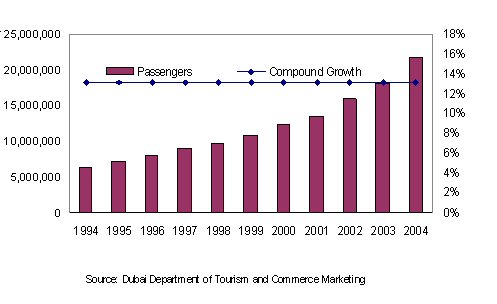
-
Over the last 11 years, the total number of passengers
at Dubai International Airport has grown at a compound
annual rate of around 13%. Despite the war in Iraq
and recent political unrest in the Middle East, the
total number of airport passengers arriving in Dubai
increased by some 13% in 2003 and 20% in 2004, reflecting
the strong competitiveness of the emirate in the economic
and leisure sectors;
-
This upward trend was further stimulated by the increased
efforts made by the government to promote the emirate
as a politically stable destination with a booming
economy and attractive leisure facilities. In addition,
Dubai has benefited from increased intra-regional
travel following the events of 11 September 2001 and
the war in Iraq;
-
Emirates is one of the most prominent airlines at
Dubai International Airport. The company has recently
opened new routes to, for example, the USA, Australia,
the UK and China. In the last 18 months, the airline
has placed orders for 41 aircraft from Airbus and
26 from Boeing. These will come into operation progressively
over the next four years, and this will undoubtedly
have a considerable and positive impact on the level
of visitation to Dubai.
Initiatives and Developments
Some
say that one-third of all construction cranes worldwide
are currently in Dubai. Given the current level of development
in the market, such a statement is possibly not an exaggeration.
Table 3 illustrates some of the major developments currently
taking place in Dubai.
Table
3: New Projects - Dubai, UAE 2005-15
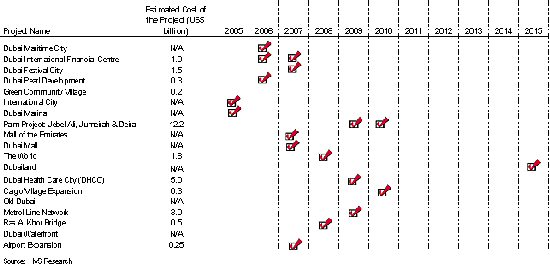
As can be seen from Table 3, there is currently an extensive
amount of new, large-scale development in Dubai that
is being developed by both the public sector and the
private sector at an estimated total cost of around
US$30 billion. Such projects relate to both leisure
and business, which is something of a reflection on
the well-balanced economic development plan for the
emirate. In addition, infrastructural projects are also
planned in Dubai, which will in all likelihood support
any growth in visitation.
Over
the last decade, Dubai has pioneered major initiatives
in the GCC region in an attempt to stimulate economic
growth and foreign direct investment. Such initiatives
and/or catalysts include the following.
-
Freehold ownership for foreigners
In May 2002 the Crown Prince of Dubai and the UAE's
Defence Minister announced that 100% freehold ownership
of certain properties in Dubai was available to all
nationalities on specific large-scale developments
(such as the Palm Islands, Dubai Land, etc) and in
certain areas of the emirate.
-
Free-Trade Zones
The government has sought to encourage global firms
to move their regional offices to Dubai by establishing
free-trade zones, such as the Jebel Ali Free Zone
(JAFZ) and, more recently, Dubai Internet City, Dubai
Media City, Dubai Knowledge Village and Dubai International
Financial Centre. Companies operating in a free-trade
zone benefit from zero duty on all imported and exported
goods and machinery within the zone, 100% foreign
ownership (no need for a local sponsor), a renewable
50-year guarantee of exemption from corporate tax,
no personal income tax and no restrictions on the
repatriation of capital and profits.
-
Obtainability of Visas
All visitors, except GCC nationals, require a visa;
however, free visit visas are issued to most nationals
entering Dubai. A visit visa is valid for up to 60
days, but can be renewed for a further 30 days upon
paying a fee of AED500 at the Department of Immigration.
Currently, nationals from more than 30 countries do
not require anymore a visa to enter the emirate/country.
Hotel Market Dynamics
Snapshot and Characteristics
The Dubai hotel market is divided into two major sub-markets:
Jumeirah Beach and the City, as shown in the following
map. Although both markets are impacted by the same
macro-economic factors, they have different characteristics
and dynamics.
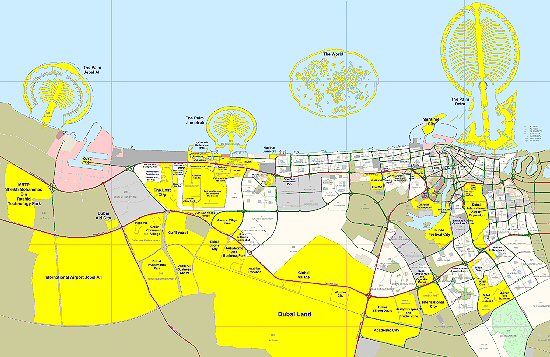
Area A: Jumeirah Beach Hotels Area B:
City Hotels
Table 4 illustrates the main characteristics of the
hotel market in Dubai. We make the following comments
on Table 4.
-
Europe is the main feeder market for five-star hotel
demand in Dubai, accounting as it does for around
47% of the total demand. The GCC and non-GCC Arab
countries account for some 27% of the total demand
for hotel accommodation. The market experienced increased
levels of intra-regional tourism following the events
of 11 September 2001 and the war in Iraq in 2003;
-
Published plans exist to attract the Turkish, Pakistani,
Indian, Chinese and Iranian markets over the next
three to five years;
-
The government is currently working on developing
the cruise market to Dubai,
which is also expected to have a positive impact on
international demand for hotel accommodation in the
area;
-
In general, the seasonality of demand is becoming
less volatile, thanks mainly to increased corporate
(and meeting and conference) demand throughout the
year. The peak in demand occurs in winter and spring;
this is attributable to the rise in the number of
arrivals from European nations, as the warm climate
is favourable for beach holidays, as well as increased
corporate and meeting and conference visitation.
Table
4: General Characteristics - Hotel Market, Dubai
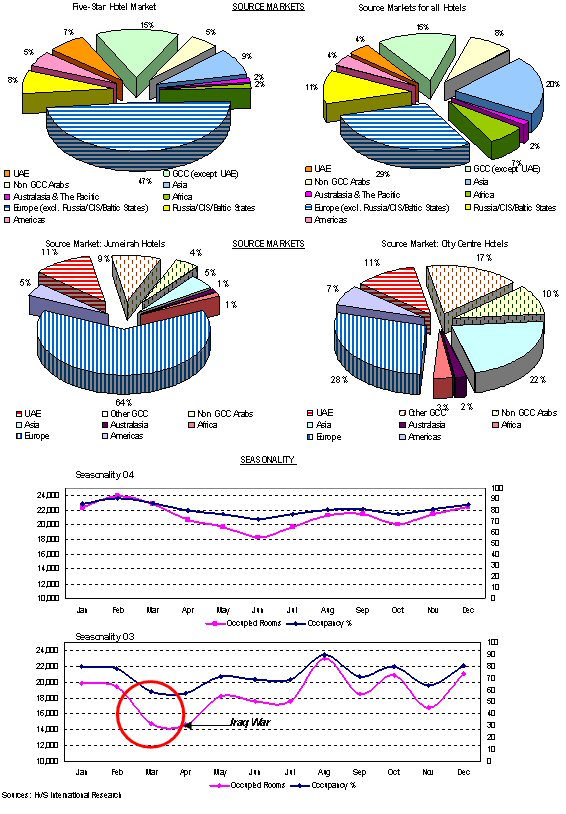
-
The main source markets for the Jumeirah Beach hotels
are European, which account for 64% of the total demand.
Interestingly, this feeder market accounts for only
28% of the total demand in the City hotel market.
This difference is down mainly to the stimuli for
the European markets, which are different from those
of the regional and GCC markets;
-
The Arab world accounts for 38% of the total demand
for City hotels and is the main source market for
the downtown hotels.
Hotel Market Performance and Dynamics
Table
5 illustrates the historical operating performance of
the hotel market in Dubai. We make the following comments
on Table 5.
-
Over the last ten years the Dubai hotel market has
outperformed the Middle East as a whole in terms of
occupancy, average room rate and, hence, RevPAR. Over
the last ten years, the market has achieved an average
occupancy of approximately 74%, which is the highest
in the region;
-
The market achieved a ten-year record performance
in 2004, with occupancy of approximately 86% and an
average rate of US$145, resulting in RevPAR of US$124.
Given the strong RevPAR performance of the market
and its revenue mix characteristics (strong demand
for food and beverage facilities), GOPPAR was US$110,
an almost 90% conversion of RevPAR;
-
In general, the market is likely to experience a slight
decrease (or stable performance) in occupancy in 2005
when compared to 2004; however, strong ADR growth
is anticipated this year (driven by firm pricing strategies
adopted by hoteliers in the market). The steady market
wide occupancy forecast for 2005 is mainly due to
the new supply that entered the market throughout
the year (Park Hyatt, Mina Al Salam, Al Qasr, etc).
However, we would stress that the total number of
room nights in the market will experience a growth
when compared to 2004 levels.
Table 5: Dubai's Historical Market Performances vs Middle
East Market Performance (US$)
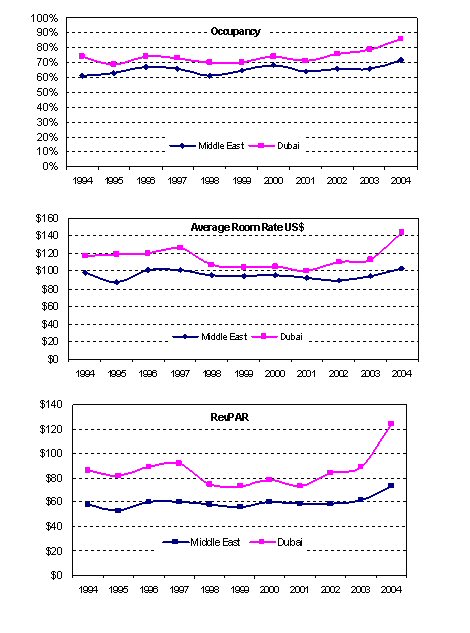
Table 6 illustrates the historical occupancy and average
room rate performance of the Jumeirah Beach and City
hotels.
-
The Jumeirah Beach hotels have outperformed the City
hotels in terms of occupancy over the last five years,
on average by a couple of percentage points;
-
Over the last five years the average room rate achieved
by the Jumeirah Beach hotels was significantly higher
than that achieved by the City hotels; this was driven
mainly by the location of such properties - on the
beach - and by their market/product positioning.
Table 6: Historical Occupancy Performance and Average
Room Rate -City Hotels vs Jumeirah Beach Hotels 1999-04
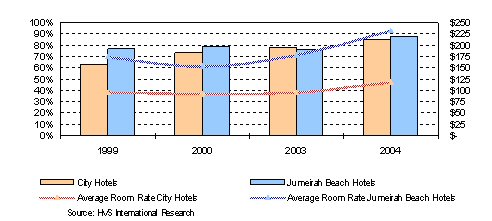
Other Asset Classes
We
make the following comments on the market characteristics
of other hotel derivatives (or relevant real estate
markets) in Dubai.
-
Given the economic boom in the emirate, and the increasing
number of expatriates visiting (or dwelling in) the
city, demand for serviced apartments has been extremely
strong. This was reflected in the strong operating
performance of this sector of the market over the
last three to five years (occupancy of approximately
87% and an average room rate of approximately US$95);
-
The residential and commercial property markets continue
to experience strong demand, and this has had a further
positive impact on the demand for hotel derivatives.
Such derivatives include serviced apartments, time
share resorts, fractional ownership properties, and
condo hotels. We would stress that while there is
a trivial relationship amongst the general real estate
markets and the various hotel derivatives in mature
markets, in emerging markets such as Dubai, we consider
the real estate market, together with the characteristics
of transient demand, are important barometers that
might signal, or otherwise, the potential demand (and
development opportunities) for various hotel derivatives.
Assessment of Future Trends
Assessment of the Threat of the New Supply, and
Historical Dynamics
From
our research, we expect between 18,000 and 20,000 hotel
rooms to enter the market by 2010, an increase of almost
100% on the current rooms supply. This will undoubtedly
fuel the risk of an oversupply emerging marketwide in
Dubai!
Table 7: Dubai's Forecast New Supply 2005-09
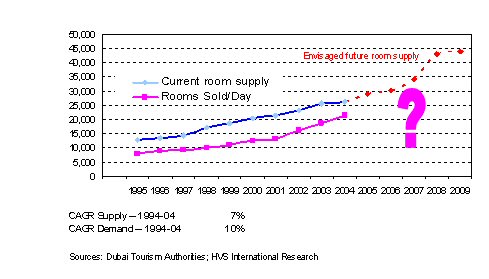
Over the last decade, hotel supply and demand in Dubai
has grown at a compound average rate of approximately
7% and 10%, respectively, which clearly reflects the
ability of the market to absorb any new level of supply,
as shown in Table 7. This could imply that demand growth
is likely to catch up with supply growth over the next
few years. In addition, we note that Dubai has a stronger
economic base than most other hotel market destinations
in the Middle East, and the emirate benefits from having
possibly the best tourism infrastructure in the region.
This might, in turn, reduce the negative impact of the
new supply.
In
keeping with other emerging markets, the public sector
drives a large proportion of the growth in the tourism
industry. We have conducted a comparative assessment
of tourism-related public spending that compares the
UAE to selected destinations in the region. We would
highlight that, while such benchmarks reflect the country
(or countries) as a whole, in the case of the UAE we
consider such investments to predominantly reflect Dubai
as most public initiatives have, so far, been geared
towards the tourism development of this emirate and,
to a lesser extent, Abu Dhabi.
Table
8 illustrates a tourism spending index in regards to
Government Expenditure and Capital Investment in the
UAE as it relates to other destinations in the Middle
East. These benchmarks were obtained from the WTTC country
reports and assessed by HVS International. We note the
following definitions of such benchmarks.
Government Expenditure (Collective) ('GS'): also
known as Non-Market Services (Collective), this category
includes operating expenditure made by government
agencies on services associated with Travel &
Tourism, but not directly linked to any individual
visitor; instead, these expenditure are generally
made on behalf of the 'community at large', such as
tourism promotion, aviation administration, security
services, resort area sanitation services, and so
forth.
Capital Investment ('GI'): also known as Capital Formation,
this category includes capital expenditure by direct
Travel & Tourism industry service providers and
government agencies to provide facilities, equipment
and infrastructure to visitors.
Table 8: Total Government Spending - GS and GI (US$)
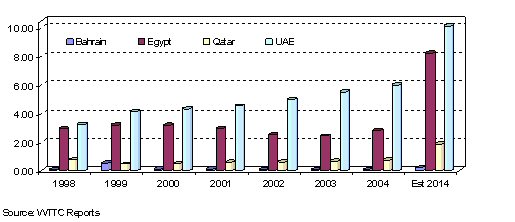
Based on an illustrative sample of four countries in
the Middle East (Bahrain, Egypt, Qatar and the UAE),
Table 8 clearly shows that the UAE (notably Dubai) is
the regional leader in terms of public expenditure on
the tourism sector. This reflects both the government's
commitment to growing the industry, as well as a 'supply-led'
hotel market.
By
2014, according to the WTTC, it is expected that Dubai
will double its current 'tourism-related' public expenditure.
We
(and many professionals in the industry) have historically
considered the hotel market in Dubai to be a 'supply-led
demand' market. This signifies that the demand for hotel
accommodation has historically been driven mostly by
the new supply and government spending associated with
it (be it on marketing, hotel/tourism investments, or
infrastructure such as the airport and airlines). Therefore,
we have conducted a relationship analysis between the
total number of rooms occupied in Dubai and the total
amount of public capital investment in the industry.
Table
9 illustrates our assessment and findings.
Table
9: Relationship Analysis - Public Spending vs Hotel
Demand
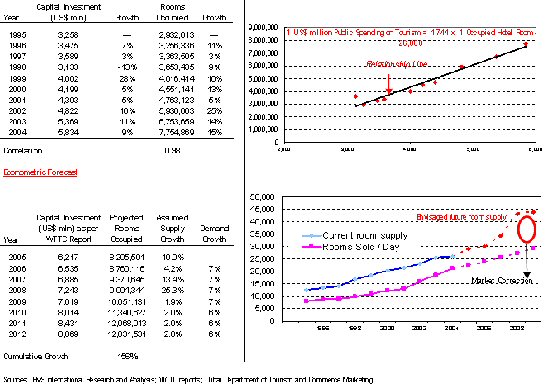
We make the following comments on Table 9.
-
The capital investment figures were provided in the
Tourism Satellite Accounting report for the UAE presented
by the World Travel and Tourism Council. The capital
investment figures are those for the UAE in general
and not Dubai in particular. We consider that Dubai,
mainly, and Abu Dhabi, to an extent, are the emirates
principally attracting public capital investment;
-
Our relationship analysis shows that the total number
of room nights in Dubai is almost perfectly correlated
to the public capital investment (on tourism) in the
UAE, at 0.98. In theory, this means that 98% of the
total number of rooms occupied (hotel demand) is explained
by the amount of capital investment in the UAE. We
note that between 1995 and 2004, only once, in 1998,
did capital investment decrease;
-
In light of the high correlation witnessed, we performed
a regression analysis between the two sets of variables.
We obtained an R² value of 0.95 (the R²
value is an indicator of how well the model fits the
data; an R² value of close to 1.0 indicates that
we have accounted for almost all of the variability
with the variables specified in the model);
-
Based on the amount of capital investment in the UAE
projected by the WTTC Tourism Satellite Account and
our relationship analysis, we forecast room nights
for the period 2005-12. Our forecast suggests that
for every 1 million AED in capital investment in the
UAE, annual room nights are likely to increase by
475. On the other hand our analysis shows that were
no capital investment to be made, then the market
would lose 26,000 room nights per annum, which clearly
demonstrates the significance of the public capital
investment (infrastructure, accommodation, and so
forth) as a determinant of future demand;
-
Using our forecast/relationship equation, and based
on the estimated amount of capital spending as per
the WTTC, our forecast suggest that room nights should
increase by 50% due to the public spending anticipated.
We stress that this analysis is a mathematical (econometric/statistical)
forecast, and is for indicative purposes only.
-
Table 9 shows that in 2008, once the new supply comes
on stream, the market performance is likely to be
adjusted when compared to its extraordinary current
performance (occupancy levels of over 90%), to reach
more reasonable performance levels. We note that such
dynamics are considered to be natural occurrences
in emerging markets such as Dubai.
Synthesis and Conclusion
General Market Performance
-
Given the historical growth in hotel demand, the forecast
public spending on tourism in the emirate, and the
current and future projects that are currently being
developed in Dubai we expect demand to experience
an average annual growth of 7%-10% over the next five
to ten years;
-
We expect the hotel market to return a strong operating
performance in 2005 and 2006. The market correction
is envisaged to take place between 2007 and 2009,
once further new supply comes on stream. From 2010
onwards, we expect the market to recover, and occupancy
to stabilise at around 70-75%, when compared to the
current occupancy levels of approximately 90%;
-
We expect the additional supply that will enter the
market to put pressure on average room rate. In 2008
and 2009, we envisage that the market will experience
a slight decline in average room rate, of approximately
5-10% (for five-star hotels);
-
Our projections and conclusions assume that the government
will continue to promote and invest significantly
in the tourism industry in Dubai.
Opportunities and Appeal
- We
consider that, given the current and future supply
and demand dynamics of the five-star hotel sector,
limited further opportunities exist for the development
of such hotels in Dubai. However, opportunities remain
for the development of such properties in other key
locations in the country;
-
We consider that significant opportunities currently
exist in the emirate (and country) for the development
of branded limited service (or three-star) hotels;
-
Opportunities remain for developing extended stay
properties in the market;
-
Given the increased level of leisure demand in Dubai,
opportunities exist for the development of timeshare
properties in the market;
-
In our opinion, the emerging nature of the residential
property market in Dubai, combined with the increased
level of demand for hotel assets (together with the
increased liquidity in the market), provide opportunities
for the development of condominium hotels and other
types of shared ownership properties in Dubai;
-
We expect that international capital (notably from
Asia and Europe) will soon start to be invested in
the hotel industry in Dubai. This will be instigated
by debt capital, followed by equity capital;
-
We expect the hotel lending transaction market in
Dubai to be very active over the next 12 months (mainly
refinancing deals). We forecast the new lending transactions
to have more aggressive terms when compared to the
conservative terms of a typical hotel senior loan
in the market (and region);
-
Short-term cash flow management will be a key area
of focus for asset managers over the next five years.
In the imminent future, long term financial structuring
will remain as the main focus;
*
* *
About the Authors and the Team
 Sarah
Leemann
is an Associate with HVS International's London office.
She joined HVS in the summer of 2004, having worked
for two years as a financial analyst for UBS in Switzerland.
She holds a Bachelor of Science in Hospitality Management
from Ecôle Hotelière de Lausanne in Switzerland.
Since joining HVS International, Sarah has conducted
numerous valuations, feasibility studies, and market
studies in Europe, Middle East and Africa. Sarah
Leemann
is an Associate with HVS International's London office.
She joined HVS in the summer of 2004, having worked
for two years as a financial analyst for UBS in Switzerland.
She holds a Bachelor of Science in Hospitality Management
from Ecôle Hotelière de Lausanne in Switzerland.
Since joining HVS International, Sarah has conducted
numerous valuations, feasibility studies, and market
studies in Europe, Middle East and Africa.
Elie Younes is an
Associate Director with HVS International's London office,
and is jointly responsible for the Middle East and Africa
region. He joined HVS  International
in 2001 having had four years' operational and managerial
experience in the hospitality industry in the Middle
East. Elie benefits from his diverse multicultural background
and speaks Arabic, English and French. He holds a BA
in Hospitality Management from Notre Dame University
in Lebanon, an MBA from IMHI (Essec Business School,
France and Cornell University, USA) and is currently
preparing his MSc in Real Estate Investment at Cass
Business School in London. Since joining HVS International,
Elie has advised on and valued various hotel (single
assets, portfolios, and company valuations) resorts,
and extended stay projects in Europe, the Middle East
and Africa. He has also given strategic advice on mid-
and large-scale developments and investment ventures
in the Middle East and Africa. International
in 2001 having had four years' operational and managerial
experience in the hospitality industry in the Middle
East. Elie benefits from his diverse multicultural background
and speaks Arabic, English and French. He holds a BA
in Hospitality Management from Notre Dame University
in Lebanon, an MBA from IMHI (Essec Business School,
France and Cornell University, USA) and is currently
preparing his MSc in Real Estate Investment at Cass
Business School in London. Since joining HVS International,
Elie has advised on and valued various hotel (single
assets, portfolios, and company valuations) resorts,
and extended stay projects in Europe, the Middle East
and Africa. He has also given strategic advice on mid-
and large-scale developments and investment ventures
in the Middle East and Africa.
 Bernard
Forster
is a Director with HVS International's London office,
heading the Middle East and Africa region together with
Elie Younes. He joined the company in 1997 from Accor
Hotels & Resorts where he was working in the IT
division, focussing on property management systems,
yield management systems and guest history systems for
Accor Hotels in Europe, the Middle East and Africa.
Previously Bernard worked in various operational management
roles for the Savoy Group in London (now Maybourne Group)
as well as in F&B for the Dolder Grand Hotel in
Zürich. Bernard holds an MSc in Property Investment
from the City University, London, a BSc (Hons) in Hotel
Management from Oxford Brookes University and a diploma
in Hotel Administration from Institut Hotelier 'Cesar
Ritz', Le Bouveret, Switzerland. Bernard
Forster
is a Director with HVS International's London office,
heading the Middle East and Africa region together with
Elie Younes. He joined the company in 1997 from Accor
Hotels & Resorts where he was working in the IT
division, focussing on property management systems,
yield management systems and guest history systems for
Accor Hotels in Europe, the Middle East and Africa.
Previously Bernard worked in various operational management
roles for the Savoy Group in London (now Maybourne Group)
as well as in F&B for the Dolder Grand Hotel in
Zürich. Bernard holds an MSc in Property Investment
from the City University, London, a BSc (Hons) in Hotel
Management from Oxford Brookes University and a diploma
in Hotel Administration from Institut Hotelier 'Cesar
Ritz', Le Bouveret, Switzerland.
About Our Team
HVS International has a team of Middle East experts
operating in the Middle East and Africa (MEA) region,
led by Elie Younes and Bernard Forster. The team benefits
from international and local cultural backgrounds, diverse
academic and hotel-related experience, in-depth expertise
in the hotel markets in the MEA region and a broad exposure
to international and established hotel markets in Europe.
Over the last 24 months, the team has advised on more
than 60 hotels or ventures in the region for hotel owners,
lenders, private equity funds, investment banks, investors
and operators. Together, this team has advised on more
than US$10 billion of hotel real estate. Our services
and expertise for the MEA region include:
-
Market and financial feasibility studies for all types
of hotel derivatives;
-
Investment counselling for mid-and-large scale 'hotel'
funds;
-
Single asset, portfolio, or business/company valuations;
-
Operator search and management contract negotiations;
-
Asset management and operational audits;
-
Assistance on financial structuring and sourcing finance.
For further information about the Middle East markets,
please contact Elie Younes or Bernard Forster.
eyounes@hvsinternational.com
+44 (0)20 7878 7728
bforster@hvsinternational.com
+44 (0)20 7878 7719
Elie Younes, MBA
Director
HVS International - London
7-10 Chandos Street
Cavendish Square
London W1G 9DQ
United Kingdom
Tel: +44 20 7878-7700
Dir: +44 20 7878-7728
Mob: +44 7985 136 205
Fax: +44 20 7878 7799
Email: eyounes@hvsinternational.com
Profile: http://www.hvsinternational.com/Personnel/Elie.Younes.aspx
© HVS International 2005
|
|

